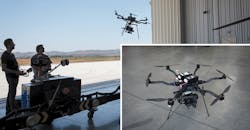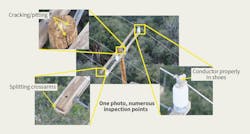Linemen once had to drive their bucket trucks to each pole to inspect poles, wires and insulators. Today, electric utilities are investing in drone technology to save time and improve the productivity of their field crews.
For example, Southern California Edison (SCE) first started talking about drones back in 2015, at a time when the rules were just evolving. The utility applied for approval with the Federal Aviation Administration (FAA) and added a few drones to its fleet.
Next, SCE trained qualified operators and started to conduct missions in the field. Rather than sending line crews to every pole in its service territory, SCE started flying drones over its transmission and distribution lines to examine the condition of its infrastructure.
Selecting Drones
Since SCE purchased its first drone from Freefly, the technology has continued to improve over time. For example, through better clarity and definition, the camera can capture more quality footage, and the drones are now more stable and can stay in the air longer than ever before.
SCE purchased two off-the-shelf drones, one from DJI and another from Sensefly, and the company placed them in its aircraft operations location. When selecting these drones, SCE focused on camera capability and size. The first drone was very small, and SCE used it as part of a pilot project to test the capabilities of a drone. The next drone was larger, had greater camera definition and had more stability in the air.
As drone technology continues to evolve and change, SCE is working to understand which model it needs to best fit field operations for its next purchase. For example, SCE recently purchased an Albris drone from Sensfly. With this "toolbox" drone, a crew member can take the drone into the field and deploy it quickly and easily to help with a specific job.
Going Beyond Line of Sight
Currently, SCE is using its drones to look for damaged infrastructure and components during line inspections. From a preventative standpoint, the utility can identify minor issues before they turn into major problems, minimizing outages and improving reliability.
At this point, electric utilities do not have blanket approval to go beyond the line of sight, unless they obtain special permission from the FAA. SCE is looking to obtain special permission from the FAA to expand the capabilities of its drones. Even if it does receive this approval, it will be very specific about where and when it wants to use the drones as part of the operation and maintenance of its transmission and distribution system.
For example, if granted approval, SCE would like to use its drones to inspect longer stretches of its transmission lines. Many of its lines cross over hills and down valleys, and the utility would like to be able to fly the drones over these areas to view the condition of the lines. Also, some of the lines are built in remote regions or mountainous territories, which are harder to access by the line crews. By deploying drones, the utility can perform inspections and environmental studies in these inaccessible locations.
Discovering Applications
As the technology evolves, the utility is trying to determine what other benefits it can achieve through the drone technology. For example, as the drones continue to get better camera definition and video quality, they can continue to look for other applications for the drones.
At its generation and hydroelectric facilities, SCE is using drones to examine penstock (large tubing), where water flows down from the mountain. In the aftermath of severe storms or other events, the utility can deploy the drones from its base camp for a more rapid damage assessment of what happened and what needs to be done to restore power. SCE also will use the drones to conduct various studies of certain protected species.
Training Operators
SCE has trained some of its pilots to operate the drones as well as its ground support and field personnel. For example, employees in the utility’s line department are working through the process of preparing to take the standard test administered by the FAA.
After passing the FAA Part 107 certification test, the prospective drone operators must pass an in-house test ride to demonstrate proficiency and actually fly the drone. The drone operators also must attend factory training and receive on-site, hands-on instruction before being fully qualified to fly the drones.
Once they learn how to fly the drones, they are discovering what they can do with the raw footage. As the drones capture still photos and videos, SCE is passing that raw data on to the proper recipients for review. In the future, SCE is exploring more efficient ways to edit, package, distribute and store that content.
Today, however, the field crews view the drone footage on a variety of different viewing technologies from laptops and tablets to smart phones. While the images are easier to view on larger screens, the viewing method depends upon the availability of the content and how quickly they need to view it.
Because the bigger image files are harder to send through email, SCE also posts some of the content to an internal site. That way, the field crews can access only the content they need to safely and efficiently do their jobs.
At this point, SCE is saving all its content because it has not had a significant number of missions. As the utility evolves, however, it is working with its corporate records center and cybersecurity team to determine an appropriate storage and retention period.
Looking Forward
SCE has flown drones on its own and also hired outside contractors to fly the drones, depending upon the application. As the space evolves, the utility will review the capabilities it can keep in house and determine what it should have a third party handle instead.
From a safety standpoint, SCE’s drone program is growing and evolving. Field crews can use the drone technology to obtain greater efficiency and time savings in the field. As regulations continue to change, SCE plans to continue using the drone technology to find new applications for the technology. ♦
Thomas Guntrip is the director of transportation services for Southern California Edison and has been with the company for 10 years. In this role, he is responsible for all of SCE’s aircraft operations, drones, fleet asset management and crane operations.
About the Author
Thomas Guntrip
Director of Transportation Services
Thomas Guntrip is the director of transportation services for Southern California Edison and has been with the company for 10 years. In this role, he is responsible for all of SCE’s aircraft operations, drones, fleet asset management and crane operations.

